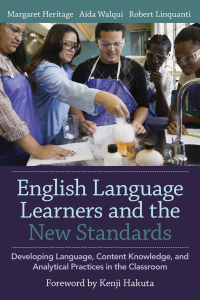by Shaeley Santiago
 College- and career-ready standards in the K-12 world have raised the bar of expectations for English Language Learners (ELLs) and their teachers. English Language Learners and the New Standards by Heritage, Walqui, and Linquanti (2015) explores ten necessary shifts in instructional practice to provide support for ELLs to learn at accelerated rates. This review will focus on the first three shifts outlined in the book.
College- and career-ready standards in the K-12 world have raised the bar of expectations for English Language Learners (ELLs) and their teachers. English Language Learners and the New Standards by Heritage, Walqui, and Linquanti (2015) explores ten necessary shifts in instructional practice to provide support for ELLs to learn at accelerated rates. This review will focus on the first three shifts outlined in the book.
“Social Process of Apprenticeship”
In contrast to the notion of language acquisition as a process that happens internally in each learner’s mind, this first shift in pedagogy builds off sociocultural theory which stresses the social nature of language learning. The interactive use of language focused on content and discipline-specific analytical skills is emphasized. By connecting language to the content of a specific discipline, the teacher creates a classroom “community of practice” where ELLs are the language apprentices. As part of the community, ELLs “…have the right to engage in ways that may be linguistically imperfect at first, but that nonetheless accomplish the work of communicating key conceptual understandings and processes” (Heritage, Walqui, & Linquanti, 2015, p. 31).
“Language as Action”
As part of a community of practice, the heavy emphasis on the forms and functions of language has been superseded by the necessity of using language to communicate ideas in order to accomplish the task of the lesson. Rather than being stuck on which verb form is correct, ELLs employ strategies such as intonation and gestures to ensure their thoughts are understood by their community members. “…Naturally occurring interaction uncovers the practices and processes of reasoning by which students make sense of what they are learning” (Heritage, Walqui, & Linquanti, 2015, p. 33).
“Acquisition Occurs in Nonlinear and Complex Ways”
Teachers may wonder what level of language proficiency a student needs before he or she can be inducted as an apprentice into the community of practice. The answer is that with the right environment, even a newcomer ELL can meaningful engage just like a toddler finds ways to communicate with caregivers. In other words, there are not prerequisite linguistic requirements before ELLs can engage with content. “…The sequencing of the language that ELLs learn and practice is determined by the conceptual and analytical development required, not the assumed complexity of the grammatical forms of the language” (Heritage, Walqui, & Linquanti, 2015, p. 34). In fact, the implication is that language learners’ progress will be stunted if they are not exposed to complex, cognitively challenging content in a supportive environment that encourages them to make purposeful contributions through their interactions with others.
In addition to outlining the changes in instructional practice that must occur if ELLs are to achieve at the level required by college- and career-ready standards, English Language Learners and the New Standards provides vignettes of classrooms where these ideas have taken root. By analyzing the vignettes and examining their own theoretical assumptions about Second Language Acquisition (SLA), teachers can adjust their instruction to create a community of practice that allows ELLs to rise to the challenge of higher expectations.
Reference:
Heritage, M., Walqui, A., and Linquanti, R. (2015). English Language Learners and the new standards. Cambridge, MA: Harvard Education Press.








